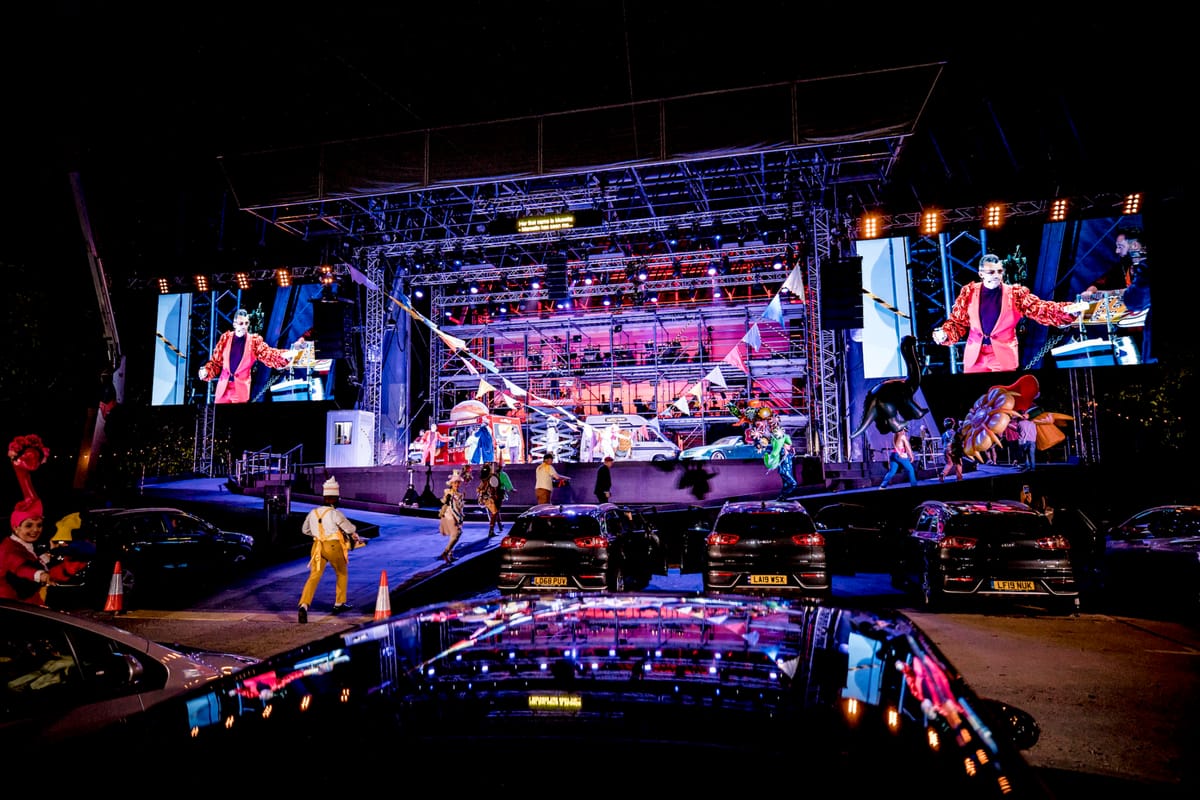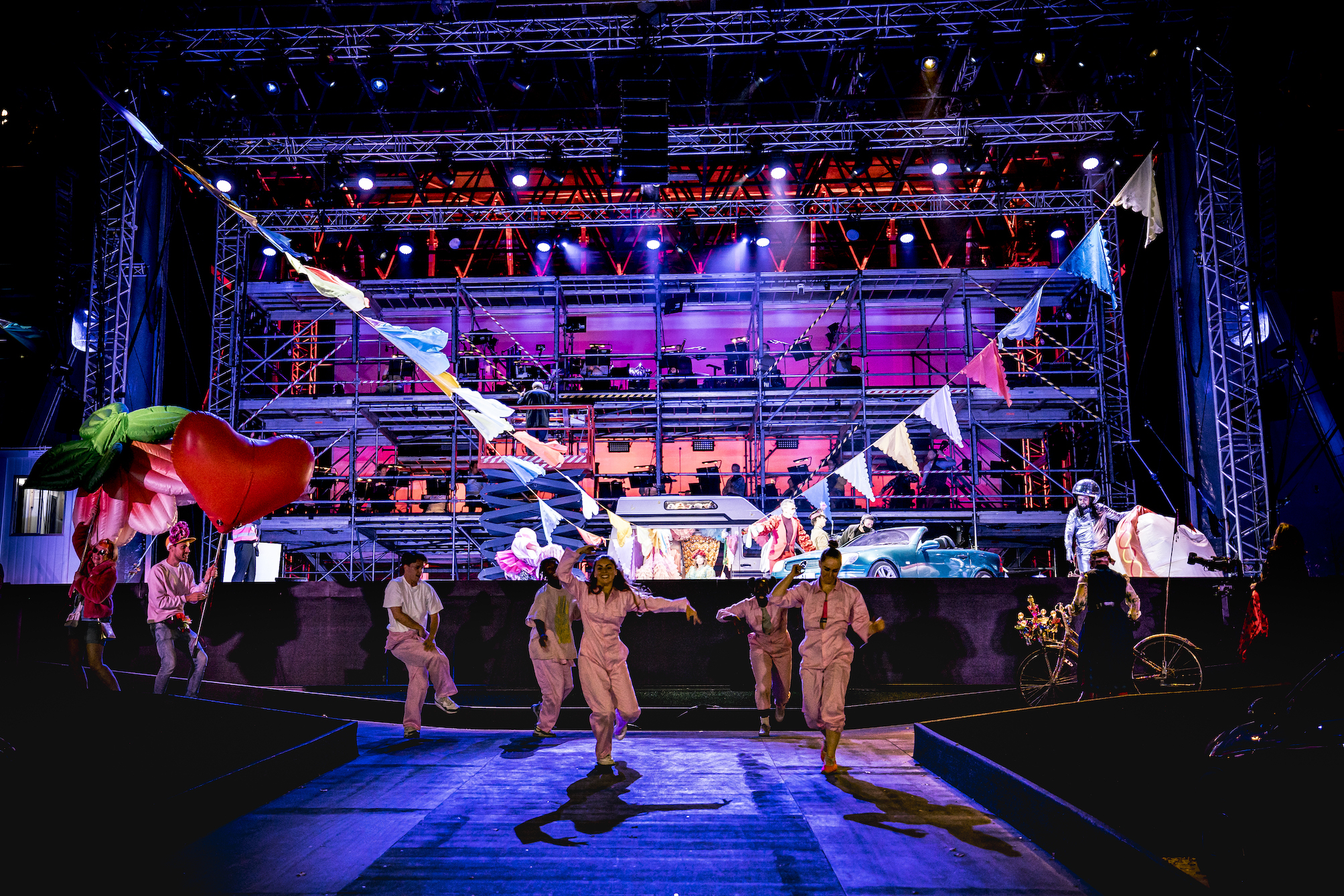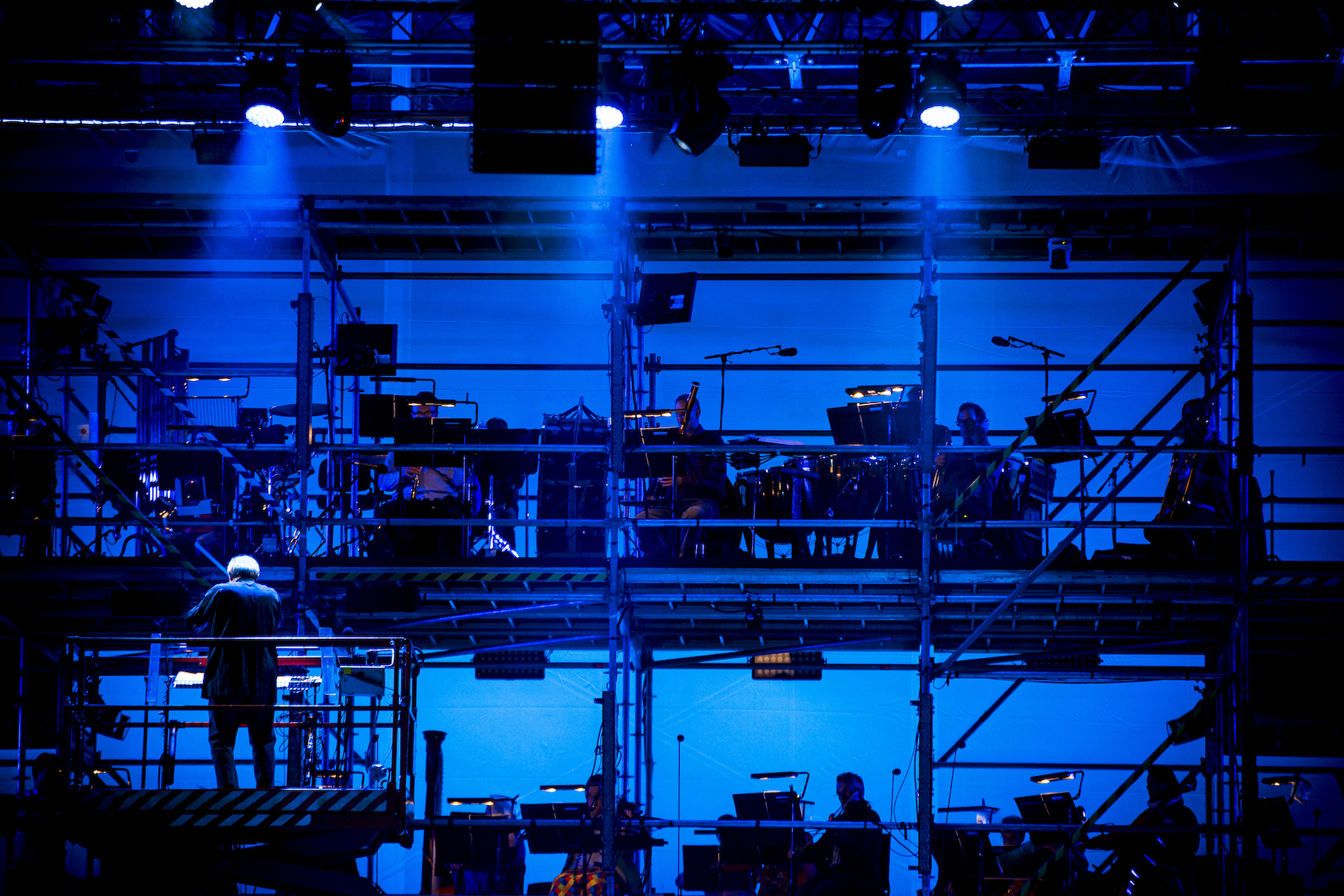A Drive for the Arts

Socially distanced seating, pre-concert disinfectant mists, music-enhancing face masks, state-of-the-art drive-in concerts – the pandemic has got us thinking on our feet. Richard Nowell, technical consultant to the NCPA and other international organisations, recounts his first-hand experience of making the English National Opera’s Drive & Live: a top-notch sonic event and how the learnings can be put to use in our outdoor spaces.
I write this from the control position at Alexandra Palace in London, waiting for the first of the day’s performances of English National Opera’s Drive & Live La bohème. The concept is a fully staged opera performed to an audience who arrive, and remain, in their cars. Bike zones have been allocated to accommodate those cyclists brave enough to climb the hill to the palace and a taxi-on-request service has provided 10 cars for those who need them.
https://www.facebook.com/watch/?v=326575951745063
It would take too long to go into the details of the logistics here, so I will only say that the build took four days with nearly 100 people working across six supply companies.
Hearing it right
When we proposed our solution to the project, Europe was in full lockdown so we needed an arrangement that avoided passing equipment into or near patrons’ cars. We very much wanted to keep away from relying solely on a simple FM radio broadcast, which was the obvious solution because Ian Dearden, the creative audio producer, and I felt that this would make the experience feel very sterile and isolating.
We have no less than three solutions working at the same time: FM radio broadcast, listened to on the patron’s car stereos; a large, distributed public address system, including rear-effects speakers, to cover a car park area of 100m by 50m without allowing sound to exceed stringent noise limits and spill over to the neighbouring houses; a dedicated Wi-Fi broadcast, allowing users to listen to broadcast-quality audio on their phones or tablets via their own headphones or Bluetooth speakers.
We have three engineers mixing the show in three different locations on-site – for the FM/Wi-Fi mix, the PA system and for handling the sound onstage for the performers. A fourth mixing desk is used to actually mix the orchestra down to groups that are fed to all the other desks, which ensures consistency whilst allowing the individual engineers to tailor their mixes for their specific purposes.

The FM broadcast, heard on the car stereos, provides a CD-quality mix that is very intimate and present. To ensure patrons feel like they are really part of something much bigger, the mix that is fed to the PA system is carefully timed to ensure it is synchronous with the cars though modern cars don’t make this easy. Over 65 loudspeakers are in use in total, both onstage and in the audience area. It also uses several ‘rear’ speakers (facing towards the stage) to provide reverb and a sense of space around the cars. The effect of the reverb machine handling this is that patrons get a studio-quality reproduction from their cars with the added sense that the performance is much bigger – as though in a giant concert hall – and is wrapping itself around them.
The Wi-Fi solution – which is really being trialled in this case – requires patrons to download an app and log on to the dedicated Wi-Fi network. This is not as difficult as it sounds and those who do are rewarded with broadcast-quality sound, without the artefacts that FM broadcast introduces.
Every person on stage has their own radio mic and their own in-ear-monitor.
Every mic not only appears for all our consoles but also is split to the company broadcasting the performance live.
Pandemic protocols
There are two separate sets of performers known as red and blue bubbles with alternating day on and day off so that if someone gets ill, we can isolate a section without losing a show.
The snag is that to keep everyone safe from COVID transmission, our radio mic team has had to come up with complex protocols to remain socially distanced and to ensure equipment is always cleaned but also tested before use. There are nine primary cast members, 20 chorus members and 32 in the orchestra in each bubble. We have provided both bubbles with their own mics and earphones, though they share (cleaned) radio packs. Our stage sound engineer has to ensure every single person can hear what they want at all times. Bear in mind that performers sing from the car park and from inside cars as well as onstage so the radio logistics are complex to say the least.

We have over 30 ways of audio intercom and communications systems on-site, 40 video screens just relaying information to all the key people, including Martyn Brabbins who conducts from a scissor lift 3.5 m over the stage.
The show is shot and mixed live on video to the two main screens hung left and right over the access ramps that allow the performers to drive their vehicles from the audience onto the stage during the show. The video set-up deserves an article of its own but involves six fixed camera points, three cameras set up inside vehicles and live footage from a camera wielded (as part of the action) by a member of the cast. This is far from easy to achieve and is all done from a tiny control room in a customised van backstage.
How this might relate to the NCPA
As India starts to come out of lockdown, it is of course our intention to use lessons learnt from experiences elsewhere. The NCPA management has spent considerable effort to gather information from colleagues all over the world. There are many similarities between the challenges presented by this production in London and those facing the NCPA in Mumbai.
I do not propose to talk about the NCPA digital project here as that is a huge undertaking and should be dealt with separately. Suffice to say the NCPA’s online presence is being upgraded and developed into something of which all India can be proud.
We are keen to bring audiences back to our campus the moment it is truly safe to do so. Operating procedures have been developed and tested to allow audience members to come and go safely and a huge variety of possibilities have been explored and tested.
It is likely that the first spaces we can safely use will be our open-air spaces, most notably the Open Air Plaza (OAP). We know this space works well from events held pre-lockdown and it can be made into a comfortable, welcoming space for audiences to gather. Under these new conditions, however, we are intending to bring performances to the space itself, rather than using the OAP as an extended foyer. Safety being our primary concern, our focus is on social distancing, providing enough facilities for patrons to avoid crowding, and a robust cleaning regimen.
From a technical point of view, we must respect our neighbours and sound levels are the primary point of concern. All necessary permissions for performances are sought as a matter of course but to really use the spaces properly we want to use a solution that does not generate noise pollution of any sort. Mr. Nayan Kale has already carried out tests of a Wi-Fi solution very similar to the one we are using in London and what we learn from ENO’s project will translate directly into improving the solution for patrons of the NCPA. By the time we open to guests, we will be confident of providing an excellent audio experience to every person in the OAP.
Our experience of recording both video and audio for in-house performances stands us in good stead in this regard and the experiences gained in particular with the Symphony Orchestra of India in the last four years is invaluable for providing live relays with all the pressures and demands that it involves. It will need care, thought and quite some investment in both time and money but the NCPA has a track record of rising to such challenges. Neither Mr. Kale’s technical team nor NCPA management are afraid of meeting challenges head-on.
Projectors will be used to throw images of the performance (or indeed a film) onto the side of the Jamshed Bhabha Theatre (JBT) and our new video department, headed by Mr. Sankalp Meshram, and developed through our desire to improve online content, will be able to mix live content onto that screen whenever necessary.
Performers can be on a stage in front of the JBT or even in the JBT or Tata Theatre depending on individual show requirements, with the audience enjoying the live experience of those performances in the open air. We know we can make this work with our colleagues from Mumbai and around the world and we expect to bring truly high-quality work to our patrons without putting anyone at unnecessary risk.
We look forward to welcoming you back to our campus.
This piece was originally published by the National Centre for the Performing Arts, Mumbai, in the November 2020 issue of ON Stage – their monthly arts magazine.





